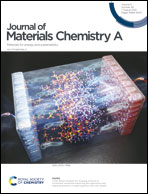Black-to-transparent electrochromic capacitive windows based on conjugated polymers†
Abstract
A black-to-transparent electrochromic capacitive window (BTECCW) is explored through the combination of a dual electrochromic polymer (ECP) and a capacitive polymer layer. A black-colored polymer (PEB1) is obtained using 3,3-bis((2-ethylhexyloxy)methyl)-3,4-dihydro-2H-thieno[3,4-b][1,4]dioxepine and 4,7-dibromo-2,1,3-benzothiadiazole monomer, through a concerted metalation–deprotonation pathway. A high color contrast ECP layer is obtained by coating a poly(3,3-bis(bromomethyl)-3,4-dihydro-2H-thieno[3,4-b][1,4]dioxepine) (PR-Br) layer on ITO glass and then coating PEB1 over PR-Br to form a dual ECP layer. A porous and ordered polyaniline film is grown from aniline interfaced-graphene flakes, to provide a capacitive layer with a high surface area (31.8 m2 g−1) and electrical conductivity (25 S cm−1). The combination of the above ECP and capacitive layer affords a highly transparent (>75%) and a large color contrast (65%) BTECCW, which shows a large energy density (26.9 W h kg−1) and a power density (23.9 kW kg−1). The redox energy of the BTECCW is stored and used to fuel an electronic clock and R-LED. These results confirm that BTECCWs can function as a battery for energy storage while being a smart window that can control the blocking and transmission of visible light. A 10 × 10 cm2 size BTECCW is demonstrated, to feature the scalability of the electrochromic capacitive window.



 Please wait while we load your content...
Please wait while we load your content...